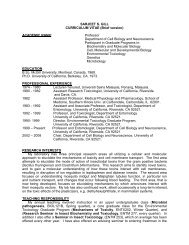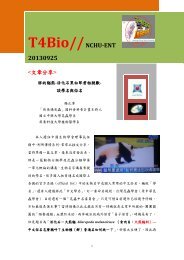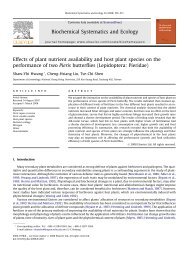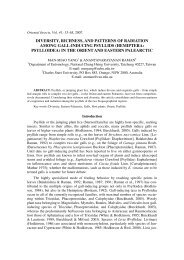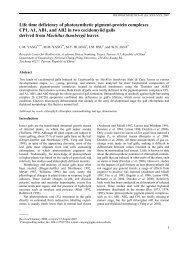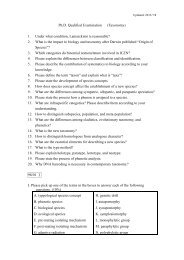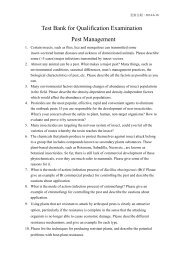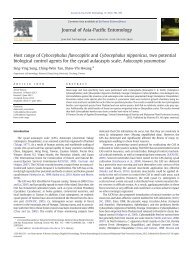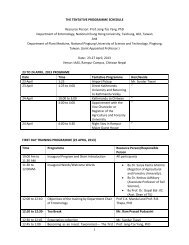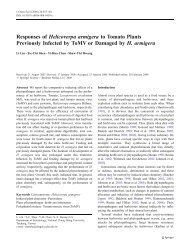Chi, H., and H. Liu. 1985. Two new methods for the study of insect ...
Chi, H., and H. Liu. 1985. Two new methods for the study of insect ...
Chi, H., and H. Liu. 1985. Two new methods for the study of insect ...
Create successful ePaper yourself
Turn your PDF publications into a flip-book with our unique Google optimized e-Paper software.
INSECT POPULATION ECOLOGY 229<br />
<strong>for</strong> j=m (<strong>the</strong> last column)<br />
? n ij =d (i-1) (j-1) n (i-1) (j-2) g (i-1) j n (i-1) j<br />
To calculate <strong>the</strong> stable age-stage-distribution,<br />
we set n 11 =1, <strong>and</strong> <strong>the</strong>n derive <strong>the</strong><br />
frequencies <strong>for</strong> all o<strong>the</strong>r ages <strong>and</strong> stages colum<br />
by column using <strong>the</strong> above equations. A<br />
computer program <strong>for</strong> this tedious calculation<br />
is inevitable. As <strong>the</strong> stable age-stage-distribution<br />
is obtained, <strong>the</strong> stable age distribution.<br />
<strong>and</strong> <strong>the</strong> stable stage distribution can be easily<br />
found by summation. For populations with<br />
stage differentiation, <strong>the</strong> stable stage distribution<br />
is obviously more interesting <strong>and</strong><br />
meaningful than <strong>the</strong> stable age distribution.<br />
AN EXAMPLE WITH DIAMONDBACK<br />
MOTH<br />
(1) Material <strong>and</strong> Method<br />
A laboratory population <strong>of</strong> diamondback<br />
moth, Pultella xylostella (L.), was used in this<br />
experiment. For <strong>the</strong> <strong>study</strong> on developmental<br />
time <strong>and</strong> survivorship <strong>of</strong> each preadult stages,<br />
100 fresh leaves <strong>of</strong> Brassica oleracea L. var.<br />
acephala DC, each with one <strong>new</strong>ly laid egg, were<br />
kept separately in petri dishes (9 cm dia.) until<br />
pupation. The fresh leaves were af<strong>for</strong>ded every<br />
day <strong>and</strong> <strong>the</strong>ir stems were wrapped with wet<br />
cotton-wool to maintain <strong>the</strong> freshness <strong>of</strong> <strong>the</strong><br />
leaves. The developmental <strong>and</strong> survival rate<br />
<strong>of</strong> eggs, four larval instars <strong>and</strong> pupae were<br />
recorded daily. When <strong>the</strong> pupae appeared, each<br />
pupa was removed into a finger tube (1cm<br />
dia., 4 cm height), <strong>the</strong>n <strong>the</strong> developmental time<br />
<strong>and</strong> sex were recorded as <strong>the</strong> adults emerged.<br />
The emerged adults were released by pairs<br />
into a plastic cylinder (15 cm dia., 20cm<br />
height) with a fresh leaf <strong>for</strong> egg laying. A<br />
small glass tube (1 cm dia., 1 cm height) with<br />
30% honey solution was served as food <strong>for</strong><br />
adults. All eggs laid in <strong>the</strong> previous day<br />
were counted <strong>and</strong> <strong>the</strong> number <strong>of</strong> surviving<br />
adults were recorded.<br />
The whole life table studies were conducted<br />
in <strong>the</strong> incubators (2 ).<br />
Fig. 3. Stage-frequency distribution <strong>of</strong> P. xylostella at 25. (E-egg stage, L 1 -first<br />
larval instar, L 2-4 -second to fourth larval instars, P-pupal stage, F- female,<br />
M-male).



